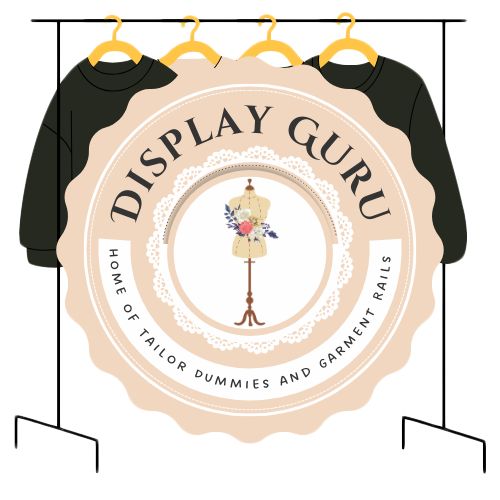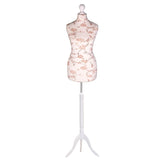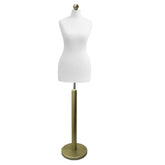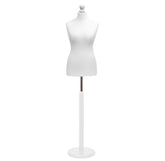Choosing a Sewing Machine With Cabinet
A sewing machine with cabinet isn't just a piece of furniture; it's a complete, dedicated sewing station. It creates a stable, comfortable, and brilliantly organised space that tackles all those common sewing frustrations – the clutter, the bad posture, and the shaky machine vibrations that drive you mad. This setup can genuinely transform your creative process from chaotic to calm and focused.
Why a Sewing Cabinet Is More Than Just Furniture
Let’s be honest for a moment. Sewing on the dining room table is a compromise. You're constantly fighting for space, the lighting is never quite right, and you have to pack everything away the second you're done. It's a never-ending cycle of setting up and tearing down that can kill your creative spark before you’ve even threaded the needle.
This is exactly where a sewing cabinet changes everything.
Think of it like cooking. You can get by in a cluttered corner of a kitchen, but imagine working in a space designed by a chef. One is a chore; the other is a joy. A proper cabinet gives your machine a permanent, solid home, which immediately cuts down on the vibrations that cause skipped stitches and that annoying rattling noise.
Evolving from Simple Tables to Creative Hubs
Modern sewing cabinets have come a long way from being just a basic table with a hole cut out of it. Today’s designs are sophisticated, smart workstations built for the needs of modern sewists and their often-complex machines.
They’re packed with features that actually make a difference:
- Ergonomic Lifts: These allow you to effortlessly raise or lower your machine to the perfect height, saving your back and neck during those marathon sewing sessions.
- Integrated Storage: Custom-built drawers and trays keep your threads, bobbins, scissors, and other bits and bobs organised and right where you need them.
- Expandable Surfaces: Many models come with drop-leaf extensions. These are fantastic for creating a huge, flat surface when you're cutting fabric or wrestling with a large quilt.
This evolution towards all-in-one workstations shows just how much the craft of sewing is valued today. The demand is undeniable, with the UK importing sewing machines valued at several million Pounds each year between 2017 and 2023. These integrated cabinets are perfect for hobbyists and small business owners who need a workspace that's both highly functional and looks good in their home. You can dig into the numbers yourself by reviewing the UK's sewing machine import data on Statista.com.
A purpose-built cabinet transforms sewing from a temporary activity into a permanent, accessible part of your home and creative life. It's an investment in your comfort, organisation, and ultimately, your passion for the craft.
When you create a dedicated sewing zone, your whole workflow becomes smoother and distractions fade away. To get a better feel for how you could set up your own space, take a look at our guide on inspiring sewing room ideas.
The Real Benefits of a Dedicated Sewing Station

When you move beyond just storing your machine and create a dedicated sewing station, you'll notice a real difference in your creative process. Investing in a proper sewing machine with cabinet isn't just about tidiness; it’s an investment in your comfort, efficiency, and ultimately, the quality of your work. The perks go far beyond simply having a place to park your machine.
These purpose-built units are designed to solve the everyday frustrations that many of us face. From the nagging back pain caused by poor posture to the constant hunt for a missing spool of thread, a dedicated cabinet offers practical solutions that make your sewing time more productive and, frankly, more enjoyable.
Superior Ergonomics for Comfortable Crafting
Let's talk about ergonomics. Sewing for hours at the dining room table or a makeshift desk almost always leads to hunching over. The result? A sore back, a stiff neck, and aching shoulders. This kind of discomfort can cut a creative session short and turn a beloved hobby into a bit of a chore.
A sewing cabinet is built to put your machine at the perfect height. Many even have an adjustable lift, which lets you set the machine's base perfectly flush with the tabletop. This creates a huge, flat surface that supports your fabric and allows your arms to work at a natural, relaxed angle, taking a massive amount of physical stress out of the equation.
A study on workplace ergonomics found that a proper workstation setup can reduce musculoskeletal symptoms by up to 61%. Applying this same principle to your sewing space means you can work longer and feel better doing it.
This ergonomic setup isn't a luxury; it's essential for anyone who spends serious time at their machine. To understand its value, think about any specialised furniture designed to make a job easier, like how choosing the best work storage bench can completely change how a workshop functions.
Clever Organisation and Unmatched Stability
A well-thought-out sewing cabinet brings calm to the chaos. With built-in drawers, trays, and special holders for notions, all your essential tools—from scissors and thread to bobbins and pins—finally have a proper home. Everything is right where you need it, which means no more wasted time digging through baskets and more time focused on your actual project. If you're looking to take things a step further, you can explore our detailed guide on https://www.displayguru.co.uk/blogs/news/sewing-room-organization.
Finally, stability is a complete game-changer. A standard table can vibrate and shake when your machine gets up to speed, which often leads to skipped stitches and a lot of noise. A solid, heavy cabinet absorbs those vibrations beautifully.
The benefits are immediate:
- Quieter Operation: Less rattling means a more peaceful sewing environment for you and everyone else at home.
- Cleaner Stitches: A stable machine produces consistent, even stitches, giving your projects a much more professional finish.
- Aesthetic Appeal: When you’re done for the day, many cabinets are designed to hide the machine away completely. Your workspace transforms back into an attractive piece of furniture that fits right in with your home décor.
Finding the Right Cabinet Type for Your Space
Choosing a sewing cabinet isn't just about picking a piece of furniture; it’s about designing your creative space. Think of it like this: you wouldn't use a small writing desk to cook a five-course meal. The same logic applies here. The right cabinet has to fit not just your room, but also your workflow and the scale of your ambitions.
For sewists working in smaller homes or multi-purpose rooms, a compact, space-saving cabinet is a brilliant solution. When closed, they often masquerade as a simple side table, but open up to reveal a dedicated sewing station. At the other end of the scale, you have the magnificent armoires – these are the complete command centres for serious crafters, boasting huge storage capacity and massive cutting surfaces.
Comparing Popular Cabinet Styles
If you've got a dedicated corner or a bit more room to play with, a mid-size cabinet often hits the sweet spot. They’re a fantastic middle ground, offering more storage than their compact cousins and clever features like drop-leaf extensions for cutting fabric or managing a large quilt. It's this blend of organisation and workspace that makes them a go-to for hobbyists who are serious about their craft but don't have a whole studio to fill.
And if you're really pushed for space, don't despair. We've got a whole host of clever tricks in our guide on small sewing space ideas.
The image below breaks down the essential benefits you should expect from any well-designed sewing cabinet, no matter its footprint.

As you can see, it's all about creating a foundation of comfort and organisation that ultimately lets your creativity flow without interruption.
Matching a Cabinet to Modern Machines
Sewing is more popular than ever. The UK sewing machine market pulled in around USD 116.7 million in revenue in 2024, and that's projected to grow to USD 136.3 million by 2030. A huge part of that growth is down to today's incredible computerised machines, which now make up nearly 46.19% of the market. These aren't your grandmother's Singers; they often come with features like LED lighting and digital displays, so they need a cabinet that can accommodate their modern design and electronic needs.
To help you visualise the options, let's break down the main styles. This table should give you a clearer idea of what might work for you.
Sewing Cabinet Types at a Glance
| Cabinet Type | Best For | Key Features | Pros | Cons |
|---|---|---|---|---|
| Compact | Small flats, multi-use rooms, or occasional sewists. | Folds down to a small footprint; often has a simple machine lift mechanism. | Space-saving; discreet when not in use. | Limited work surface and minimal storage. |
| Mid-Size | Dedicated hobbyists with a designated sewing corner. | Drop-leaf extensions for more surface area; multiple drawers; air-lift mechanism. | Great balance of function and size; versatile for various projects. | Needs a permanent spot; can be heavy. |
| Full-Size Armoire | Serious quilters, dressmakers, or crafters with a studio. | Expansive worktop; vast storage for fabric and notions; heavy-duty construction. | An all-in-one workstation; keeps everything organised and hidden. | Requires significant space; a major investment. |
Ultimately, finding the perfect sewing machine with cabinet comes down to being honest about your space and how you sew. When you match the furniture to your creative habits, you end up with a workstation that feels less like a purchase and more like a partner in your craft.
Key Features to Look for Before You Buy

Choosing the right sewing machine with cabinet isn't about finding some mythical "perfect" model. It’s about finding the perfect fit for your machine, your space, and the way you create. Getting this right from the start makes all the difference, saving you headaches and adding a real touch of comfort and efficiency to your sewing for years to come. This guide will walk you through the features that genuinely matter, so you can invest with confidence.
Before you get carried away with a cabinet's beautiful finish or clever design, let's nail down the most important thing: will it actually fit your sewing machine? This is the absolute first step. You'll need to get out the tape measure and note your machine's precise width, depth, and height.
Then, compare those numbers to the cabinet's specs, paying close attention to the machine opening size and, crucially, the weight capacity of its lift mechanism. The heavier, computerised machines need a really sturdy lift to work smoothly and safely.
It’s a classic mistake to buy a cabinet that just fits the machine. You'll thank yourself later for allowing a few extra inches of clearance all around for moving your hands, changing bobbins, and just generally not feeling cramped.
Matching the Cabinet to Your Room and Workflow
Once you know a cabinet can host your machine, you need to think about how it will live in your home. Don't just measure the cabinet's basic footprint and call it a day; consider its full "in-use" size.
Will you have enough space to swing open all the doors and pull out the drawers without them hitting a wall? Is there room for a drop-leaf extension to be fully raised? A great tip is to use masking tape to mark out the cabinet's complete dimensions on your floor, including any extended parts. It gives you a much better sense of how it will really occupy the space.
Next up is getting real about your storage needs. It's so easy to underestimate how much fabric, thread, and haberdashery we all collect over time.
- Your Fabric Stash: Are you a quilter with stacks of fat quarters, or a dressmaker with long rolls of fabric? Be honest about how much space it takes up.
- Tools and Notions: Think about where you'll keep your cutting mats, rulers, scissors, and spools of thread. Cabinets with different-sized drawers can be a huge help here.
- Work Surface: Do you work on large projects that need a big surface for cutting and laying out patterns, or is a more compact top enough for what you do?
Thinking this through will help you decide between a grand cabinet with acres of storage and something a bit more streamlined. For more ideas on getting organised, our article on choosing a sewing table with storage has some brilliant tips.
Understanding Material Quality and Durability
Finally, let's talk about what the cabinet is made of. The materials directly impact its stability, how long it will last, and, of course, the price.
Solid wood is the top-tier choice. It offers fantastic durability and does an excellent job of dampening vibrations from your machine, but it is the most expensive option. Medium-Density Fibreboard (MDF) is a very popular and strong alternative, giving you great stability and a smooth surface, usually protected by a laminate finish.
Laminate-covered particleboard is the most budget-friendly material, but it can be more prone to wear and tear or moisture damage over the long run. Investing in a high-quality MDF or solid wood cabinet means your sewing station will be a stable, reliable partner for countless projects ahead.
Getting Your New Sewing Haven Ready
So, your new sewing machine with cabinet has just been delivered. The excitement is probably palpable! Now comes the task of turning that box of parts into the heart of your creative space. A bit of planning now will save you a world of headaches later and set you up for years of enjoyable sewing.
Before you even think about picking up a screwdriver, take a moment to lay out all the hardware. Get everything out of the bags and group the screws, bolts, and various fittings. This simple act of sorting can transform a potentially chaotic assembly into a straightforward, almost paint-by-numbers process.
Setting Up Your Station for Success
With the cabinet built, the real fun begins: organising it to match your unique workflow. Think about the rhythm of how you sew and arrange everything to make your movements feel natural and effortless.
- Your Go-To Drawer: This should be for the tools you reach for constantly. Think scissors, your trusty seam ripper, pins, and the threads you use most often.
- Secondary Storage: Dedicate other drawers to the items you need, but not every single minute. This is the perfect spot for special presser feet, machine oil, and those spare needles.
- The Work Surface: Clutter is the enemy of creativity. Try to keep this main area as clear as you can. A pin cushion and a small bin for fabric scraps should be within easy reach, but not directly in your way.
Organising like this helps build muscle memory. Soon enough, you'll be able to grab what you need without even looking, keeping you completely in the creative zone. If you want to explore this further, we have a comprehensive guide on creating the perfect sewing room setup.
A well-organised sewing station is more than just a tidy space—it's a productivity powerhouse. When you stop wasting time hunting for tools, all your mental energy can be poured directly into your craft.
Looking After Your Investment
To keep your cabinet looking great and functioning perfectly for years, a little maintenance goes a long way. A gentle wipe with a soft, damp cloth is all it takes to clean the finish; stay away from harsh chemical cleaners, as they can damage the surface over time.
It's also a good idea to periodically check and tighten any bolts, especially after the first few months as things settle into place. Give the lift mechanism a quick test now and then to make sure it's running smoothly, clearing out any dust that might have gathered in its tracks. A simple routine like this will keep your sewing haven in prime condition.
This is particularly important for vintage or refurbished models, which are making a real comeback. It’s a growing trend, with the UK Sewing Machine Market forecast to expand by over USD 20 million by 2028. This growth is partly fuelled by a renewed appreciation for these beautiful, functional heritage pieces. Bonafide Research has some fascinating insights into why these classic setups are finding a new generation of fans.
Building Your Ideal Creative Workspace

As we've seen, choosing a sewing machine with cabinet is far more than just a purchase; it's a genuine investment in your craft. You're not just buying a piece of furniture. You're creating a dedicated, personalised space that elevates your sewing from a simple hobby into a fulfilling passion.
Think of it as the command centre for your creativity. A well-designed cabinet provides a rock-solid, stable base that stops frustrating machine wobble in its tracks. More than that, smart storage puts every tool, thread, and bobbin right where you need it, exactly when you need it. This seamless setup lets you stay completely lost in the creative flow, without hunting for a lost pair of scissors.
From Good Intentions to a Great Setup
The real goal here is to build an environment that doesn't just work, but actively helps your ideas come to life. It's about creating a workstation that supports you every single stitch of the way. Now you know what to look for.
- Assess Your Space: First, take a proper look at your current sewing corner. How would a purpose-built cabinet transform it?
- Prioritise Your Needs: What's a deal-breaker for you? Is it a huge work surface for quilting, or is an ergonomic machine lift the top priority for your back?
- Embrace Organisation: This is the perfect excuse for a fresh start. A new cabinet gives you the chance to completely rethink your workflow for peak efficiency.
Once your new workspace is ready, keeping it that way is the next step. Getting some expert tips on organizing your craft supplies can be a massive help.
Investing in a proper sewing station is about giving your creativity the respect and support it deserves. You are creating a space that not only functions beautifully but also inspires you to start your next project with confidence.
With the right foundation in place, you’re well on your way to building the comfortable, inspiring sewing room you've always imagined.
Your Questions Answered
Taking the plunge and investing in a proper sewing cabinet is a big decision, so it's only natural you'll have a few questions. Let's walk through some of the most common queries to help you feel confident you're making the right choice for your sewing room.
Will My Sewing Machine Fit in Just Any Cabinet?
That's the million-dollar question, and the short answer is no. This is probably the single most important thing to check before you buy. Sewing machines come in all shapes and sizes, from petite vintage models to heavyweight computerised quilting machines, so a one-size-fits-all approach just doesn't work.
Before you fall in love with a cabinet, get out your tape measure. You need the exact width, depth, and height of your sewing machine. Then, compare those numbers to the cabinet’s machine opening dimensions, which the manufacturer should provide. Don't forget to check the weight limit for the lift mechanism either. An underpowered lift and an overweight machine are a recipe for disaster.
What Exactly Is an Airlift Mechanism, and Do I Need One?
Think of an airlift as a helping hand for your sewing machine. It’s a clever gas-strut system that lets you effortlessly glide your machine into one of three positions. It truly is a game-changer for ergonomics.
- Storage Position: The machine disappears completely below the tabletop, giving you a clear, flat surface for cutting or other crafts.
- Flat-Bed Position: The machine base sits perfectly flush with the cabinet top. This creates an uninterrupted, smooth area that’s an absolute dream for quilters or anyone doing free-motion work.
- Free-Arm Position: The machine is raised all the way up, ready for your everyday sewing projects.
So, do you need one? Not in the strictest sense. But if you sew regularly, have a heavy machine, or find lifting awkward, it’s worth its weight in gold. It saves you from straining your back and makes getting started on a project so much easier.
An airlift isn't just a luxury feature; it's about making your sewing safer and more comfortable. It removes the physical effort that can sometimes stop you from even starting.
Can I Get a Good Quality Sewing Cabinet on a Budget?
You certainly can. While it's easy to be wowed by the top-of-the-range solid wood cabinets with a price tag to match, there are plenty of brilliant, budget-friendly options out there. Many well-known brands produce incredibly sturdy and reliable cabinets from high-quality MDF or laminate finishes.
The trick is to focus on what you truly need. If money is tight, prioritise a stable frame and a decent amount of workspace over having dozens of drawers or an airlift. You can always add storage later. Also, keep an eye on the second-hand market! You can often find beautifully made, older cabinets in fantastic condition, giving you incredible craftsmanship for a fraction of the original price.
At Display Guru, we specialise in providing the high-quality tools that bring creative and professional visions to life. Explore our full range of tailor's dummies, garment rails, and display solutions to complete your ideal workspace.








